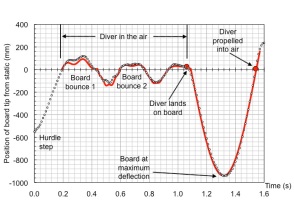I taught the mechanics of solids to mechanical engineering students for around 15 years. When it came to exams, I always tried to include examples from the real world that would stretch the most able of the students – I even had a question relating the bending of beams with the deflection of springboards during a dive.
Funny, then, that I should return to it more than a decade later to model a vibrating diving board for an Olympic coach based in Sheffield. The idea was to use the model in conjunction with high-speed video to get an understanding of the physics of the board and to use it to enhance the coaching. It was surprising to see how far you could get with simple 1st year mechanics once you understand what is going on.

Let’s take a typical male diver and an example dive with two and a half turns and one and a half twists. What you see by eye is a blur of diver and speedos running to the end of the board, bouncing up in the air once, then slamming down on the tip of the board before being propelled high into the air. During his free flight, he rotates faster than my eyes can take in before ‘plopping’ into the water leaving only a dome of boiling water and the gentle decaying bounce of the board.
The first thing to understand is the boundary conditions of the board i.e. how it is held in place. Effectively it is a pin jointed cantilever with a pivot near its middle so that the board deflects downwards from the pivot when the diver stands at its tip. The position of the pivot along the length of the board is the only thing that can be adjusted and is done so using a large wheel.
The dive is a beautiful example of the exchange of energy from one form to another and the first jump of this particular dive – officially called a hurdle step – is used to give the diver potential energy (i.e. height). The diver has the maximum potential energy at the top of the jump, which is converted to kinetic energy as they fall back towards the board. The diver has the maximum kinetic energy on impact with the tip of the board, which is then converted to strain energy of the board as it deflects to its maximum position. The strain energy is released to propel the diver high into the air to allow him to carry out his gymnastic manoeuvres.
The easiest way to understand what the board does is to listen to the noise; this tells you that there are vibrations interspersed with bounces of the board on the pivot (try it next time you watch diving). Between the hurdle step and first impact, while the diver is in the air, the board rotates up about the pin and bounces down onto the pivot twice.

When it’s on the pivot, the board vibrates as a short beam with a relatively high frequency (about 22 Hz). Conversely, when it’s not on the pivot it vibrates as a long beam with a relatively low frequency of about 8 Hz. After the 2nd bounce of the board on the pivot, the diver is on the way back down and coordinates his feet to impact with the board – and this is where it gets interesting. The board is slightly raised off the pivot, rotating slightly first up and then back down. Superimposed on top of this is the 8 Hz oscillation which at the tip appears to cancel out rotations so that the end of the board – where the diver is about to land – appears almost stationary in the air.
Getting the board to do this seems to be a combination of setting the pivot in the right place, and jumping the right height during the hurdle step to get the landing time right. A successful dive depends upon having enough time in the air to execute the rotations and twists before hitting the water. This can be done by bouncing really high off the springboard, which in turn is a function of the strain energy stored in the board. The diver intuitively sets the deflection of the board by altering the stiffness of the board using the pivot (which also affects timing).
The tip of the board was modeled using simple beam theory and damped harmonic motion – something a 1st year in engineering could put together – and gives a pretty good description of reality. So, when you watch the diving at the Olympics this summer, listen to the noise of the board and think about the rudimentary mechanics involved – it may just be appearing as an exam question.
—
This blog was based on an original for The Engineer which can be read here.